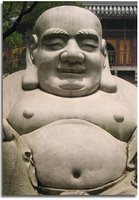
The man who became known as the 'Buddha' (Pali: 'One who knows directly') was a Hindu of high caste birth. Leaving the comforts of home life and taking up a wandering existence with little or no material support, was by no means unique to the Buddha. When he renounced the material comforts of home life, he was participating in a very ancient Hindu practice, designed for those who wanted to push their spiritual training to a higher level.
The Vedas, i.e., Hindu scriptures, have rules for virtually every single life event. There is nothing a Hindu can do in life that is not governed by the Vedas, accept to leave home and 'renounce' the guidance of the Vedas, to find the highest truth in the universe for themselves, through meditation and deprivation. These men were called 'Sramana Brahmana,' amongst other names, and they strove ceaselessly in their spiritual search. They had given up their caste and had literally become 'as nothing' within the context of ancient Hindu society. Many thousands (perhaps hundreds of thousands) went on this path. Many realized their own 'enlightenment' and gathered disciples around.
This is exactly what the Lord Buddha did. At this time (just after his enlightenment), the formal separation of lay followers from ordained disciples was not yet established, and would not be for at least another four centuries after His passing. In fact, the Lord Buddha speaks openly and fully about the 'Bahujana' or lay followers (i.e., those who have not left home). He says that it is the duty of other Sramana Brahmana who follow Him to teach openly all who come for the teachings, the emphasis being upon the calming of the mind through seated meditation AND that understanding applied to the rigors of everyday life.
Indeed, even the later Buddhist monastic tradition of 'Upasotha' is of Hindu origin, whereby a Sramana Brahmana and his followers would gather together every two weeks (on the days of the New and Full moons), and recite and discuss the sect's teachings. An early Pali word for the Buddha's sect was 'Sasana' (literally: 'Order'), They would gather on the 'moon' days and recite the core teachings, at this early time, what became known as the 'Vinaya' (i.e. 'monastic discipline) was not yet formulated.
Centuries later, a formal monastic Sangha (i.e., 'order of monks') was formed that no longer lived in the forest, or dwelled under trees, as the original Sramana Brahmana had done, but rather lived in purpose built complexes called 'viharas.' Laypeople were demoted as mere worshippers of the sangha, whose job it was to provide material help to the monks, in the hope that they would get a better re-birth!
0 comments:
Post a Comment